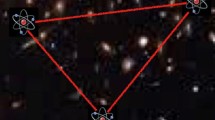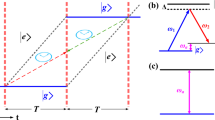Abstract
A recent proposal describes space based gravitational wave (GW) detection with optical lattice atomic clocks [S. Kolkowitz, I. Pikovsk, N. Langellier, M.D. Lukin, R.L. Walsworth, J. Ye, Phys. Rev. D 94, 124043 (2016)]. Based on their setup, we propose a new measurement method for gravitational wave detection in low frequency with optical lattice atomic clocks. In our method, n successive Doppler signals are collected and the summation for all these signals is made to improve the sensitivity of the low-frequency GW detection. In particular, the improvement is adjustable by the number of Doppler signals, which is equivalent to that the length between two atomic clocks is increased. Thus, the same sensitivity can be reached but with shorter distance, even though the acceleration noises lead to failing to achieve the anticipated improvement below the inflection point of frequency which is determined by the quantum projection noise. Our result is timely for the ongoing development of space-born observatories aimed at studying physical and astrophysical effects associated with low-frequency GW.
Graphical abstract

Similar content being viewed by others
References
S. Kolkowitz, I. Pikovsk, N. Langellier, M.D. Lukin, R.L. Walsworth, J. Ye, Phys. Rev. D 94, 124043 (2016).
K.S. Thorne, in: Three Hundred Years of Gravitation, edited by S.W. Hawking, W. Israel (Cambridge University Press, Cambridge, England, 1987).
B.P. Abbott, et al., Phys. Rev. Lett. 116, 061102 (2016).
B.P. Abbott, et al., Phys. Rev. Lett. 116, 241103 (2016).
B.P. Abbott, et al., Phys. Rev. Lett. 118, 221101 (2017).
B.P. Abbott, et al., Phys. Rev. Lett. 119, 141101 (2017).
B.P. Abbott, et al., Phys. Rev. Lett. 119, 161101 (2017).
P. Amaro-Seoane, S. Aoudia, S. Babak, et al., Class. Quantum Grav. 29, 124016 (2012).
P. Amaro-Seoane, S. Aoudia, S. Babak, et al., https://arXiv:1201.3621.
LISA: Laser Interferometer Space Antenna for the detection and observation of gravitational waves, Pre-Phase A Report, Max-Planck-Institute, MPQ 208, 1996..
P. Amaro-Seoane, et al., Class Quantum Grav. 29, 124016 (2012).
P. Amaro-Seoane et al., https://arXiv:1702.00786.
J. Luo, et al., Class. Quantum Grav. 33, 035010 (2016).
W.R. Hu, Y.L. Wu, Nat. Sci. Rev. 4, 685 (2017).
D.C. Backer, R.W. Hellings, Ann. Rev. Astro. Astrophys. 24, 537 (1986).
J. Cordes, R. Shannon, https://arXiv:1010.3785.
J.W. Armstrong, Liv. Rev. Relativ. 9, E2 (2006).
R.F.C. Vessot, et al., Phys. Rev. Lett. 45, 2081 (1980).
W.J. Kaufmann, Nature 327, 157 (1970).
R.W. Davies, Issues in gravitational wave detection with space missions, in Gravitational Waves and Radiations, Proceedings of the international conference, Université de Paris VΠ, Paris, France, June 18’22, 1973 (CNRS, Paris, France, 1974), Vol. 220, pp. 33–45.
J.C. Breidenthal, T.A. Komarek Radio tracking system, in: Deep Space Telecommunications Systems Engineering, edited by J.H. Yuen (Plenum Press, New York, 1983.
F.B. Estabrook, H.D. Wahlquist, Gen. Relativ. Gravit. 6, 439 (1975).
M. Bishof, X. Zhang, M.J. Martin, J. Ye, Phys. Rev. Lett. 111, 093604 (2013).
P.W. Graham, J.M. Hogan, M.A. Kasevich, S. Rajendran, Phys. Rev. Lett. 110, 171102 (2013).
J.M. Hogan, M.A. Kasevich, Phys. Rev. A 94, 033632 (2016).
S.-W. Chiow, J. Williams, N. Yu, Phys. Rev. A 92, 063613 (2015).
M.A. Norcia, J.R.K. Cline, J.K. Thompson, Phys. Rev. A 96, 042118 (2017).
J. Su, Q. Wang, Q. Wang, P. Jetzer, Class. Quantum Grav. 35, 085010 (2018).
N.J. Cornish, L.J. Rubbo, Phys. Rev. D 67, 022001 (2003).
R. Schilling, Class. Quantum Grav. 14, 1513 (1997).
M. Tinto, Phys. Rev. D 53, 5354 (1996).
T. Piran, E. Reiter, W.G. Unruh, R.F.C. Vessot, Phys. Rev. D 34, 984 (1986).
S.L. Larson, W.A. Hiscock, R.W. Hellings, Phys. Rev. D 62, 062001 (2000).
B. Tang, B. Zhang, L. Zhou, J. Wang, M.S. Zhan, Eur. Phys. J. D 69, 233 (2015).
A.D. Ludlow, M.M. Boyd, J. Ye, E. Peik, P.O. Schmidt, Rev. Mod. Phys. 87, 637 (2015).
H. Guan-Chyun, J.C. Hung, , IEEE Trans. Ind. Electron. 43, 609 (1996).
M.M. Boyd, T. Zelevinsky, A.D. Ludlow, S.M. Foreman, S. Blatt, T. Ido, J. Ye, Science 314, 1430 (2006).
K. Danzmann, T. Prince, P. Binetruy, P. Bender, S. Buchman, J. Centrella, M. Cerdonio, N. Cornish, A. Cruise, C. Cutler, et al., LISA: Unveiling a hidden universe, Assessment Study Report ESA/SRE, 2011, Vol. 3, p. 2.
P. Amaro-Seoane, S. Aoudia, S. Babak, P. Binetruy, E. Berti, A. Bohe, C. Caprini, M. Colpi, N.J. Cornish, K. Danzmann, et al., Class. Quantum Grav. 29, 124016 (2012).
Author information
Authors and Affiliations
Corresponding author
Additional information
Contribution to the Topical Issue “Quantum Technologies for Gravitational Physics” edited by Tanja Mehlstäubler, Yanbei Chen, Guglielmo M. Tino, Hsien-Chi Yeh
Publisher’s Note
The EPJ Publishers remain neutral with regard to jurisdictional claims in published maps and institutional affiliations.
Rights and permissions
About this article
Cite this article
He, F., Zhang, B. A protocol of potential advantage in the low frequency range to gravitational wave detection with space based optical atomic clocks. Eur. Phys. J. D 74, 94 (2020). https://doi.org/10.1140/epjd/e2020-100611-y
Received:
Revised:
Published:
DOI: https://doi.org/10.1140/epjd/e2020-100611-y




